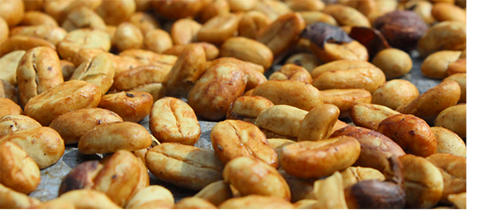PROCESSING COFFEE BY STONE METHOD
This is a new type of coffee processing in the world. This method is also misleading to many people when it comes to mixing honey into coffee beans, the fact is not so.
.jpg)
The basic principle of the honey method is that it only selects ripen fruits when harvested. The sugar content in the coffee will be at the highest level and the best quality to start processing. After harvesting enough quantities, the fruit will be put into the milling machine. With mucus still sticking on the coffee beans, they are spread on natural sun drying racks. The bamboo rafts, the black grid made of gauze a distance of a certain distance (several dozen cm),
Depending on the weather conditions, the normal drying cycle takes about 9-12 days. At the end of this period, the amount of water in the beans will be about 11-12%.
Popular ways of processing coffee:
1. Processing wet coffee (or "washed") - Coffee is brought to the factory immediately after harvesting, where the coffee is peeled off, the water tank to ferment in 30 - 36 hours , then washed and dried (usually on the cement yard)
2. Dry (or "natural") cooking - All intact coffee is dried directly on the patio, cover or roof. When dried, the hard crust of coffee is ground, leaving a stiff green coffee ready for roasting.
There are more than 70 countries in the tropics growing coffee, and so many variations of these two treatments have evolved over the years. About 7 - 8 years ago, we started to see coffee from Costa Rica and Panama called honey processed coffee. This is a variant of the "natural" coffee processing method. When the outer layer is removed, the "mucus" layer remains intact on the grain of the coffee beans. The name of this method of coffee is derived from the appearance of honey color of paddy beans after being dried for a day or longer.
If done carefully, this process can increase the sweetness and boldness of the cup of coffee. Drying techniques are very important in the honey process, as mold and mildew can easily develop if the coffee is not properly treated, dried and ventilated. Even on a small farm, honey processing requires a lot of space, labor for natural drying, and honey processing will be more costly to the producer. However, these additional costs are well rewarded when honey bee produces a clean cup of coffee with a sweet and fragrant flavor, creating a higher value. Honey Coffee Trends Start When small roasters in Japan and the United States are concerned about the quality of coffee, they have developed relationships with small producers in Costa Rica and Panama, "honey" for high-end customers.
BENEFITS OF MANUFACTURING COFFEE PROCESS - SECOND HONEY
- The important benefit of honey bean processing is that it does not use water, and thus does not pollute the environment as it does not discharge waste water like in wet processing. Compared with traditional wet processing methods. Water savings of about 2,000 liters per bag of coffee export (60kg).
Therefore, this method of green coffee processing can also be easily applied in remote areas where transportation to processing facilities is difficult and distant. On-the-spot processing may also restrict coffee from being fermented during transportation.
Another important benefit of honey processing is its economic value. The cost to invest just to buy a single shredder will be much lower than investing in a wet processing plant. In addition, the use of scaffolding also saves large amounts of electricity and fossil fuels compared to drying. Therefore, this is one of the most environmentally friendly types of green coffee to date.

COMPARE COFFEE AND WET PROCESSING
The processing of honey has the same characteristics as coffee mink. We choose the best quality red ripe coffee. Then the coffee is fermented in the mink stomach and dried in the sun in nature. Honey-sun-dried coffee is processed with all the mucilages still attached and also affects the sweetness of the coffee. The result of the honey tasting is generally unique, characterized by its distinct sweetness, fruit aroma and sweet and sour taste that are clearly enhanced to give the taste and aroma of a cup of coffee. It is attractive, not lose much when compared with "pure mink" (natural type does not use chemicals).
These honey coffees are not significantly different or spectacular when compared to quality wet wines, but there is indeed a difference. Honey honey is characterized by its sweetness and distinct aroma





.jpg&w=170&h=90&zc=2)





